 Notes: Hebden Bridge station is by no means an architectural gem, but it is a wonderfully preserved and refurbished example of a small town station, the likes of which could be found throughout the British railway network until the 1960s when closure, or demolition of the old buildings and their replacement with ‘bus’ shelters, almost eliminated them; as such it is a place to savour. Knaresborough and Hexham are two other stations in northern England of similar size and character, although these have not retained the pre-Grouping signage found at Hebden Bridge. Notes: Hebden Bridge station is by no means an architectural gem, but it is a wonderfully preserved and refurbished example of a small town station, the likes of which could be found throughout the British railway network until the 1960s when closure, or demolition of the old buildings and their replacement with ‘bus’ shelters, almost eliminated them; as such it is a place to savour. Knaresborough and Hexham are two other stations in northern England of similar size and character, although these have not retained the pre-Grouping signage found at Hebden Bridge.

Hebden Bridge station has, rightly, won awards reflecting its ‘heritage’ value and the quality of its floral displays. Considering the modest size of the town it serves (fewer than 6,000 inhabitants), today Hebden Bridge station is heavily used (estimated 764,000 passengers in 2014-15, increased from 368,000 in 2004-05). The station car park is quickly filled in the morning, and throughout the day parked cars line the A646 (Burnley Road) from Station Road for almost half a mile towards Mytholmroyd, such is its popularity with commuters. Hebden Bridge is ideally placed as a residential town for people who work in such employment centres as Halifax, Bradford, Leeds, Blackburn, Rochdale and Manchester. Its frequent service makes it a useful railhead for the hamlets and villages scattered on the surrounding hillside and moorland, such as Heptonstall. In the nineteenth and early twentieth centuries Hebden Bridge station welcomed numerous visitors to the scenic Hardcastle Crags, but since the early 1980s the town itself has become is a tourist ‘honeypot’, its station being used by visitors throughout the day. Although it is some way from the town centre, the ten-minute walk from the station through Calder Holmes Park, adjacent to the Rochdale Canal, is delightful and the visitors can look forward to a wide choice of cafés and pubs where they may slake their thirst and satisfy their hunger.
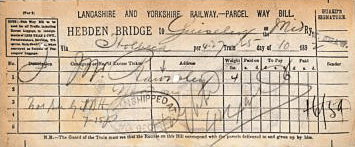 The original station at Hebden Bridge dated from the opening of the railway on 5 October 1840. Until 1 January 1841 it was the western terminus of the line from Leeds and Normanton; on this date the line was extended through Eastwood and Todmorden to the northern end of the Summit Tunnel. From 1 March 1841, when the line through the tunnel was opened to meet the existing rails from Manchester, trains used the entire route through Hebden Bridge between Manchester and Leeds. At Hebden Bridge the building was on the down (Leeds-bound) platform, of two storeys aligned at right angles to the platform and with a pitched roof which prominently overhung the gables, rather in the style of some G T Andrews buildings on the York & North Midland Railway. A goods warehouse was placed to the north-west of the platform. On the up platform there were no facilities, but a single-road engine shed backed onto it. The first timetable (when Hebden Bridge was the western terminus) showed departures to Leeds at 8.00 and 11.30am and at 3.15pm; arrivals from Leeds were at 9.36 and 11.50am and 4.50pm. At Normanton passengers could change for York, Hull, Sheffield and Derby and from there to Birmingham and London. A horse-drawn coach conveyed passengers to and from Littleborough pending the completion of Summit Tunnel. The original station at Hebden Bridge dated from the opening of the railway on 5 October 1840. Until 1 January 1841 it was the western terminus of the line from Leeds and Normanton; on this date the line was extended through Eastwood and Todmorden to the northern end of the Summit Tunnel. From 1 March 1841, when the line through the tunnel was opened to meet the existing rails from Manchester, trains used the entire route through Hebden Bridge between Manchester and Leeds. At Hebden Bridge the building was on the down (Leeds-bound) platform, of two storeys aligned at right angles to the platform and with a pitched roof which prominently overhung the gables, rather in the style of some G T Andrews buildings on the York & North Midland Railway. A goods warehouse was placed to the north-west of the platform. On the up platform there were no facilities, but a single-road engine shed backed onto it. The first timetable (when Hebden Bridge was the western terminus) showed departures to Leeds at 8.00 and 11.30am and at 3.15pm; arrivals from Leeds were at 9.36 and 11.50am and 4.50pm. At Normanton passengers could change for York, Hull, Sheffield and Derby and from there to Birmingham and London. A horse-drawn coach conveyed passengers to and from Littleborough pending the completion of Summit Tunnel.
Below is the timetable issued on the day that Manchester Victoria station opened, replacing the original terminus at Oldham Road:
Up trains: weekdays January 1844 |
Destination |
Down trains: weekdays |
Destination |
7.18am |
Manchester Victoria |
5.40 (Wed only) |
Leeds Hunslet Lane |
9.12am |
Manchester Victoria |
8.00am |
Leeds Hunslet Lane |
10.45am |
Manchester Victoria |
9.00am (starts here) |
Leeds Hunslet Lane |
3.11pm |
Manchester Victoria |
10.26am |
Leeds Hunslet Lane |
5.45pm |
Manchester Victoria |
2.46pm |
Leeds Hunslet Lane |
8.02pm |
Manchester Victoria |
4.48pm |
Leeds Hunslet Lane |
8.59pm |
Manchester Victoria |
5.55pm |
Leeds Hunslet Lane |
- |
- |
8.32pm |
Leeds Hunslet Lane |
Up trains: Sunday |
Destination |
Down trains: Sunday |
Destination |
9.12am |
Manchester Victoria |
9.33am |
Leeds Hunslet Lane |
9.27pm |
Manchester Victoria |
8.23pm |
Leeds Hunslet Lane |
Bradshaw of February 1863 shows a more frequent service than the earlier timetable. Destinations of trains are not always clear in timetables of this date, so Normanton might not be the final destination of some down trains:
Up trains: weekdays February 1863 |
Destination |
Down trains: weekdays |
Destination |
7.35am |
Manchester Victoria |
5.30am |
Normanton |
9.21am |
Manchester Victoria |
7.31am |
Normanton |
10.28am |
Manchester Victoria |
9.35am |
Normanton |
12.38pm |
Manchester Victoria |
11.20am |
Normanton |
2.10pm |
Manchester Victoria |
1.33pm |
Normanton |
2.40pm |
Manchester Victoria |
3.10pm |
Normanton |
4.55pm |
Fleetwood |
4.55pm |
Normanton |
6.35pm |
Manchester Victoria |
6.16pm |
Normanton |
7.31pm |
Manchester Victoria |
7.32pm |
Normanton |
9.43pm |
Manchester Victoria |
9.42pm |
Normanton |
Up trains: Sunday |
Destination |
Down trains: Sunday |
Destination |
8.37am |
Manchester Victoria |
9.00am |
Normanton |
12.34pm |
Manchester Victoria |
11.19am |
Normanton |
7.57pm |
Manchester Victoria |
5.51pm |
Normanton |
9.43pm |
Manchester Victoria |
9.03pm |
Normanton |
In the 1870s waiting accommodation was added at Hebden Bridge on the up platform by converting the disused engine shed, and the diminutive platform shown on the Tait lithograph of 1845, reproduced below, was widened and lengthened. The local newspaper carried reports that this waiting room was cold in winter and dusty in summer, but further improvements were not made until the 1890s. In 1872 single sidings were constructed south-east of the station off both the up and down lines, and when widening took place in 1906 these were extended to west of Mytholmroyd viaduct and converted into loops.
 The passenger accommodation proved to be inadequate so in 1891/92 new buildings were constructed by the Lancashire & Yorkshire Railway (LYR). Biddle (1973) describes the architecture of the new building as ‘a cheerful smaller edition’ of Nelson station (1892), some 12 miles to the west. At Hebden Bridge the sandstone main building is on the down platform (No.2) today used by trains towards Halifax, Bradford, Mirfield and Leeds. Its central two-storey section which contains the booking hall has a Mansard roof broken by three tall dormers, the central one surmounted by a gable. A bold cornice divides the upper from the lower storey. Single-storey wings, stepped back slightly from the central section, extend on either side, each under a hipped roof. The north-western wing contained the parcel office, but a café (the ‘Coffee Station’) now operates from this room. In the south-eastern wing are a waiting room and toilets. As the land drops away to the south-east, that end of the building is carried on an ‘undercroft’ storey. The upper storey was the stationmaster’s quarters (now used by a children’s nursery). On the platform elevation a handsome, hipped glazed awning with a deep valance extends the full length of the building, supported by a series of iron columns and brackets containing a wheel motif in the spandrels. The up platform (No.1) used by trains to Rochdale, Manchester, Burnley, Blackburn and Preston is backed by a screen wall and is sheltered by a lengthy awning of the same design. At the north-western end of the screen wall is a waiting room. The staggered platforms are connected by a subway, oddly reached by stairs on the down side and a ramp on the other. A hydraulic luggage lift, understood to be the oldest in place at any British station, but no longer used, connects the down platform with the subway. The passenger accommodation proved to be inadequate so in 1891/92 new buildings were constructed by the Lancashire & Yorkshire Railway (LYR). Biddle (1973) describes the architecture of the new building as ‘a cheerful smaller edition’ of Nelson station (1892), some 12 miles to the west. At Hebden Bridge the sandstone main building is on the down platform (No.2) today used by trains towards Halifax, Bradford, Mirfield and Leeds. Its central two-storey section which contains the booking hall has a Mansard roof broken by three tall dormers, the central one surmounted by a gable. A bold cornice divides the upper from the lower storey. Single-storey wings, stepped back slightly from the central section, extend on either side, each under a hipped roof. The north-western wing contained the parcel office, but a café (the ‘Coffee Station’) now operates from this room. In the south-eastern wing are a waiting room and toilets. As the land drops away to the south-east, that end of the building is carried on an ‘undercroft’ storey. The upper storey was the stationmaster’s quarters (now used by a children’s nursery). On the platform elevation a handsome, hipped glazed awning with a deep valance extends the full length of the building, supported by a series of iron columns and brackets containing a wheel motif in the spandrels. The up platform (No.1) used by trains to Rochdale, Manchester, Burnley, Blackburn and Preston is backed by a screen wall and is sheltered by a lengthy awning of the same design. At the north-western end of the screen wall is a waiting room. The staggered platforms are connected by a subway, oddly reached by stairs on the down side and a ramp on the other. A hydraulic luggage lift, understood to be the oldest in place at any British station, but no longer used, connects the down platform with the subway.
 The rebuilding of the station coincided with the provision of a new signal box in 1891. Originally known as Hebden Bridge East it was equipped with a 36-lever LYR frame, later extended to 38 levers. Hebden Bridge West box, which was situated adjacent to the goods yard, closed in 1934 and was replaced with a 2-lever ground frame released from the existing box. The rebuilding of the station coincided with the provision of a new signal box in 1891. Originally known as Hebden Bridge East it was equipped with a 36-lever LYR frame, later extended to 38 levers. Hebden Bridge West box, which was situated adjacent to the goods yard, closed in 1934 and was replaced with a 2-lever ground frame released from the existing box.
The goods warehouse was rebuilt in 1877, a large, stone structure under a pitched roof. Its upper floor was used for grain storage, for which purpose there were three hoists on the south-eastern elevation over the taking-in doors, enclosed in timber housing (lucams). A second bay was added in 1884 to the north-western elevation of the existing warehouse.
In January 1922 Hebden Bridge was transferred from LYR to London & North Western Railway (LNWR) ownership when the companies merged; for some years the LYR and LNWR had enjoyed improved relations and co-operation, and in the enlarged LNWR there was strong representation of LYR officials. The merger anticipated the ‘Grouping’ one year later when the LNWR was absorbed into the new London, Midland & Scottish Railway (LMS). The following timetable shows the services from Hebden Bridge during the year when it was part of the LNWR. In the final column Bradford (Exchange) and Leeds (Central) are shown as Bradford and Leeds. Some down trains are divided and the two destinations are shown (e.g.) Bradford/Leeds; in this case trains are divided at Low Moor station. In th opposite direction trains would be amalgamated here.
Up trains: weekdays July 1922 |
Destination |
Down trains: weekdays |
Destination(s) |
4.31am |
Manchester Victoria |
5.32am |
Bradford/Normanton† |
7.12am |
Manchester Victoria |
7.26am |
Bradford |
7.32am |
Manchester Victoria |
7.48am |
Normanton |
7.50am |
Manchester Victoria |
8.29am |
Halifax |
8.12am (Mon & Sat) |
Blackpool Central |
8.56am |
Sowerby Bridge |
8.29am |
Rochdale |
9.08am |
Bradford/Leeds |
9.06am |
Blackpool Central § |
9.38am |
Halifax |
9.13am |
Manchester Victoria |
9.57am |
Wakefield Kirkgate |
9.56am |
Manchester Victoria |
11.37am |
Sowerby Bridge |
10.25am Mon/Tue/Fri |
Colwyn Bay ‡ |
12.19pm |
Bradford |
10.33am |
Manchester Victoria |
1.26pm |
Bradford |
10.56pm exc Wed/Thu |
Blackpool Central |
1.58pm |
Wakefield Kirkgate |
11.37am |
Manchester Victoria |
2.26pm |
Bradford |
12.02pm Sat only |
Blackpool Central |
3.46pm Mon &Sat only |
Wakefield Kirkgate |
12.09pm |
Manchester Victoria |
3.53pm |
Wakefield Kirkgate ¶ |
1.05pm |
Manchester Victoria |
4.09pm |
Bradford/Leeds |
2.13pm |
Manchester Victoria |
5.12pm |
Bradford/Leeds |
2.36pm Sat only |
Blackpool Central |
5.39pm |
Halifax |
4.18pm |
Manchester Victoria |
6.19pm |
Halifax |
5.00pm |
Rochdale |
6.46pm |
Normanton |
5.17pm |
Manchester Victoria |
7.06pm |
Sowerby Bridge |
5.33pm |
Todmorden |
7.47pm |
Bradford |
6.19pm |
Manchester Victoria |
8.13pm |
York |
6.50pm |
Manchester Victoria |
8.42pm |
Halifax |
7.34pm |
Rochdale |
9.33pm |
Bradford |
8.19pm |
Blackpool Central § |
10.34pm |
Bradford/Leeds |
9.15pm |
Manchester Victoria |
- |
- |
9.51pm |
Manchester Victoria |
- |
- |
10.57pm Tue &Sat only |
Todmorden |
- |
- |
Up trains: Sunday |
Destination |
Down trains: Sunday |
Destination(s) |
7.50am |
Manchester Victoria |
9.20am |
Sowerby Bridge |
10.42am |
Manchester Victoria |
11.26am |
Bradford/Leeds |
12.20pm |
Manchester Victoria |
11.41am |
Normanton |
2.40pm |
Manchester Victoria |
2.59pm |
York |
3.36pm |
Manchester Victoria |
5.15pm |
Bradford/Normanton |
7.23pm |
Manchester Victoria |
7.31pm |
Bradford |
7.54pm |
Manchester Victoria |
7.40pm |
Bradford |
10.07pm |
Manchester Victoria |
8.50pm |
Normanton |
§ Down train via the Copy Pit route ‡ Calls to take up for North Wales ¶ via Cleckheaton † Train possibly divides en route to serve several destinations: not entirely clear in the timetable
 Under LMS administration the station retained its Victorian atmosphere, and the company imposed its character in a limited way by installing ‘Sugg’ gas lamps, lamp nameplates and distinctive ‘Hawkseye’ nameboards with black lettering on a yellow field. Shortly before the Second World War Hebden Bridge’s train service had become generous, particularly on summer Saturdays when extra trains called travelling to or from resorts such as Blackpool, Morecambe and Llandudno. The intervals between trains in this timetable remain erratic. A couple of long-distance services run to Newcastle and to Edinburgh / Glasgow. As in the 1922 timetable, Bradford (Exchange) and Leeds (Central) are shown as Bradford and Leeds. Some down trains are divided and the two destinations are shown (e.g.) Bradford/Leeds; in this case trains are divided at Low Moor station. In the opposite direction trains would be amalgamated here. Under LMS administration the station retained its Victorian atmosphere, and the company imposed its character in a limited way by installing ‘Sugg’ gas lamps, lamp nameplates and distinctive ‘Hawkseye’ nameboards with black lettering on a yellow field. Shortly before the Second World War Hebden Bridge’s train service had become generous, particularly on summer Saturdays when extra trains called travelling to or from resorts such as Blackpool, Morecambe and Llandudno. The intervals between trains in this timetable remain erratic. A couple of long-distance services run to Newcastle and to Edinburgh / Glasgow. As in the 1922 timetable, Bradford (Exchange) and Leeds (Central) are shown as Bradford and Leeds. Some down trains are divided and the two destinations are shown (e.g.) Bradford/Leeds; in this case trains are divided at Low Moor station. In the opposite direction trains would be amalgamated here.
Up trains: weekdays July 1938 |
Destination(s) |
Down trains: weekdays |
Destination(s) |
4.33am |
Liverpool Exchange |
5.30am |
Normanton † |
6.03am (Mon exc) |
Manchester Victoria |
6.06am |
Halifax |
7.12am |
Manchester Victoria |
7.20am |
Bradford |
7.34am |
Manchester Victoria |
7.46am |
Normanton |
7.52am |
Manchester Victoria |
8.28am |
Halifax |
8.22am (Sat only) |
Blackpool Central § |
8.51am |
Sowerby Bridge |
8.27am |
Rochdale |
9.08am |
Leeds |
9.08am |
Blackpool Central § |
9.33am |
Halifax |
9.16am |
Manchester Victoria |
9.58pm |
Wakefield Kirkgate |
9.32am (Sat only) |
Morecambe Euston Rd |
11.08am (Sat only) |
Normanton |
9.53am |
Manchester Victoria |
11.40am |
Wakefield Kirkgate |
10.35am |
Manchester Victoria |
11.56 (Sat exc) |
Bradford |
10.54am |
Blackpool Central § |
12.18 (Sat only) |
Newcastle |
11.20am (Sat only) ¶ |
Llandudno |
12.30 (Sat only) |
Bradford |
11.36am (Sat exc) |
Manchester Victoria |
1.28pm |
Bradford |
11.36am (Sat only) |
Blackpool Central § |
1.58pm |
Normanton |
12.03pm (Sat only) |
Southport § |
2.26pm |
Bradford |
12.07pm (Sat only) |
Blackpool Central |
3.22pm (Sat only) |
Wakefield Kirkgate ¶ |
12.10pm (Sat exc) |
Blackpool North § |
3.40pm (Sat only) |
Goole |
12.14pm (Sat only) |
Manchester Victoria |
3.47pm (Sat only) |
Halifax |
12.17pm (Sat exc) |
Manchester Victoria |
3.48pm (Sat exc) |
Halifax |
1.05pm (Sat exc) |
Middleton Junction |
3.53pm (Sat exc) |
Wakefield Kirkgate ¶ |
1.09pm (Sat only) |
Middleton Junction |
4.08pm |
Bradford / Leeds |
1.29pm (Sat only) |
Blackpool Central § |
4.37pm (Sat only) |
Leeds |
2.16pm |
Man Vic/Blackpool C§ |
4.53pm (Sat only) |
Bradford |
2.35pm Sat 23&30 July |
Blackpool Central |
5.02pm (Sat only) |
Low Moor |
3.05pm (Sat exc) |
Manchester Victoria |
5.12pm (Sat exc) |
Bradford / Leeds |
3.08pm (Sat only) |
Manchester Victoria |
5.21pm (Sat exc) |
Halifax |
4.19pm |
Rochdale |
5.29pm (Sat exc) |
Leeds |
5.01pm (Sat exc) |
Rochdale |
5.36pm (Sat exc) |
Bradford |
5.05pm (Sat only) |
Rochdale |
5.39pm (Sat only) |
Halifax |
5.16pm |
Manchester Victoria |
6.15pm (Sat exc) |
Halifax |
5.28pm (Sat only) |
Todmorden |
6.24pm (Sat only) |
Halifax |
5.35pm (sat exc) |
Todmorden |
6.54pm |
Normanton |
5.48pm |
Manchester Victoria |
7.18pm |
Sowerby Bridge |
6.17pm (Sat exc) |
Manchester Victoria |
7.52pm |
Bradford / |Leeds |
6.22pm (Sat only) |
Manchester Victoria |
7.59pm (Sat only) |
Bradford ø |
6.48pm |
Manchester Victoria |
8.14pm |
York |
7.29pm (Sat exc) |
Rochdale |
8.47pm |
Leeds |
7.39pm (Sat only) |
Rochdale |
9.14pm (Sat only) |
Bradford |
7.44pm (Sat only) |
Blackburn § |
9.39pm |
Bradford |
8.26pm |
Preston § |
10.38pm |
Bradford / Leeds |
9.13pm |
Manchester Victoria |
12.12am (Sat exc) |
Sowerby Bridge |
9.54pm |
Manchester Victoria |
12.21am (Sat only) |
Halifax |
11.18pm |
Manchester Victoria |
- |
- |
11.32pm (Fri only) |
Edinburgh / Glasgow |
- |
- |
12.13am |
Terminates here |
- |
- |
Up trains: Sunday |
Destination |
Down trains: Sunday |
Destination(s) |
7.53am |
Manchester Victoria |
9.18am |
Sowerby Bridge |
8.55am |
Blackpool Central § |
11.35am |
Bradford / Leeds |
10.47am |
Manchester Victoria |
11.51am |
Normanton |
11.10am |
Manchester Victoria |
12.05pm |
Bradford |
11.16am |
Blackpool North § |
3.00pm |
York |
12.10pm |
Manchester Victoria |
3.18pm |
Bradford / Leeds |
1.11pm |
Blackpool Central § * |
5.15pm |
Bradford / Normanton |
2.40pm |
Manchester Victoria |
7.29pm |
Bradford |
3.34pm |
Manchester Victoria |
7.37pm |
Bradford / Leeds |
5.11pm |
Manchester Victoria |
8.53pm |
Normanton |
7.10pm |
Manchester Victoria |
9.11pm |
Wakefield Kirkgate |
7.58pm |
Manchester Victoria |
9.29pm |
Bradford / Leeds |
8.36pm |
Manchester Victoria |
9.48pm |
Bradford / Leeds |
10.06pm |
Manchester Victoria |
10.28pm 10 & 17 July |
Bradford |
- |
- |
10.28pm 24 & 31 July |
Bradford / Leeds |
- |
- |
10.59pm |
Halifax |
§ Down train via the Copy Pit route ‡ Calls to take up for North Wales ø Calls to set down from North Wales ¶ via Cleckheaton † Train possibly divides en route to serve several destinations: not entirely clear in the timetable * Calls when required to set down
 At nationalisation in January 1948 the LMS lines in England and Wales became the basis of the new British Railways’ London Midland Region; however, all of the Leeds and Bradford area’s lines were transferred to the North Eastern Region (NE) on 2 April 1950 and Hebden Bridge became the frontier NE station. The NE Region retained the station’s LYR and LMS signs but painted them in the region’s cheerful tangerine colour. At nationalisation in January 1948 the LMS lines in England and Wales became the basis of the new British Railways’ London Midland Region; however, all of the Leeds and Bradford area’s lines were transferred to the North Eastern Region (NE) on 2 April 1950 and Hebden Bridge became the frontier NE station. The NE Region retained the station’s LYR and LMS signs but painted them in the region’s cheerful tangerine colour.
The following table for June to September 1955 was the first to appear in the NE Region timetable, although the station had been administered by this region for over five years. As with the 1922 and 1938 timetable summaries, above, in the final column Bradford (Exchange) and Leeds (Central) are shown as Bradford and Leeds. Some down trains are divided and the two destinations are shown (e.g.) Bradford/Leeds; in this case trains are divided at Low Moor station. In the opposite direction trains would be amalgamated here.
Up trains: weekdays 13 June 1955 |
Destination |
Down trains: weekdays |
Destination(s) |
4.26am |
Manchester Victoria |
5.27am |
Normanton |
4.40am |
Manchester Victoria |
7.17am |
Bradford |
7.16am |
Liverpool Exchange |
7.47am |
Normanton |
7.53am |
Manchester Victoria |
8.53am |
Bradford/Leeds |
8.21am |
Manchester Victoria |
9.56am |
Wakefield Kirkgate |
9.15am Sat excepted |
Blackpool Central § |
11.11am Sat excepted |
Bradford/Leeds |
9.18am Sat only |
Blackpool Central § |
12.48pm Sat only |
Leeds |
9.24am |
Blackpool Central § |
1.00pm Sat only |
York |
10.00am |
Manchester Victoria |
1.05pm |
Bradford/Leeds |
11.54am |
Liverpool Exchange § |
1.19pm Sat from 16/7 |
Bradford |
12.49pm Sat only |
Manchester Victoria |
1.54pm Sat only |
Normanton |
1.05pm |
Manchester Victoria |
2.12pm |
Bradford/Leeds |
1.54pm |
Manchester Victoria |
3.26pm Sat only |
Bradford/Leeds |
3.01pm Sat only |
Manchester Victoria |
3.37pm Sat excepted |
Bradford/Wakefield K |
3.14pm Sat from 25/6 |
Liverpool Exchange |
3.43pm |
Halifax Town |
5.01pm Sat excepted |
Manchester Victoria |
4.09pm |
Bradford/Leeds |
5.17pm Sat only |
Manchester Victoria |
5.13pm |
Bradford/Leeds |
5.34pm Sat excepted |
Todmorden |
5.33pm |
Halifax Town |
5.57pm Sat only |
Liverpool Exchange |
5.56pm |
York |
6.07pm Sat excepted |
Liverpool Exchange |
6.17pm Sat excepted |
Halifax Town |
6.26pm Sat only |
Manchester Victoria |
7.00pm |
Normanton |
6.37pm Sat excepted |
Manchester Victoria |
7.44pm |
Bradford |
7.31pm Sat only |
Manchester Victoria |
8.10pm |
York |
7.35pm Sat excepted |
Manchester Victoria |
8.47pm |
Leeds |
8.23pm |
Preston § |
9.15pm Sat excepted |
Bradford/Leeds |
10.01pm |
Manchester Victoria |
9.23pm Sat only |
Bradford |
11.15pm Sat only |
Manchester Victoria |
10.34pm |
Bradford/Leeds |
- |
- |
12.01am Sat only |
Halifax Town |
Up trains: Sunday |
Destination |
Down trains: Sunday |
Destination(s) |
7.50am |
Manchester Victoria |
9.22am |
Normanton |
8.15am |
Liverpool Exchange § |
9.41am |
Leeds |
9.22am |
Blackpool Central § |
3.17pm |
Bradford/Leeds |
10.16am |
Manchester Victoria |
5.07pm |
Normanton |
10.43am |
Manchester Victoria |
7.26pm |
Bradford |
11.52am |
Blackpool Central § |
7.38pm |
Leeds |
2.41pm |
Liverpool Exchange |
8.55pm |
Normanton |
3.33pm |
Manchester Victoria |
9.13pm |
Bradford/Leeds |
7.18pm |
Manchester Victoria |
9.28pm |
Bradford/Leeds |
7.58pm |
Manchester Victoria |
10.26pm |
Bradford/Leeds |
10.05pm |
Manchester Victoria |
10.52pm |
Bradford/Leeds |
Although diesel traction was introduced on 14 June 1954 between Leeds, Bradford and Halifax – the first service to be so favoured by British Railways, and a great success as there was a fourfold increase in passengers in four years – it was not until 1 January 1962 that the main Calder Valley service through Hebden Bridge was taken over by diesels.
The Reshaping of British Railways (‘Beeching Report’) of March 1963 did not recommend the Manchester-Halifax-Leeds ‘Calder Valley’ route for closure, but the Copy Pit route (Todmorden / Hall Royd Junction to Rose Grove) was condemned and it closed on 1 November 1965. By the time of the Beeching Report all of the intermediate stations on the Copy Pit route had closed, as had some on the Manchester – Leeds route such as Eastwood and Luddendenfoot.
 In the service shown below for summer 1964 the off-peak departures from Hebden Bridge have become at least approximately hourly apart from an early-afternoon gap in the up service, plus seasonal extras on Saturday. A few trains still travel westwards via Copy Pit. This was the final summer when trains ran to Blackpool Central; Beeching (1963) had proposed closure of Blackpool North station, but the town council had notions of an ambitious development on the site of Central station (which did not materialise) and insisted that Central should close instead, with longer-distance trains being diverted to Blackpool North. In the summer 1962 timetable the practice of dividing trains at Low Moor into Bradford Exchange and Leeds Central portions at Low Moor ceased and trains ran through to Leeds, reversing at Bradford: no problem for DMUs. In the same timetable through workings were introduced via Bradford (reverse) and Leeds (reverse) to Harrogate. Through trains to Harrogate ran until September 1967, but from 1 May when Leeds Central closed they were diverted via Leeds City (reverse). In the service shown below for summer 1964 the off-peak departures from Hebden Bridge have become at least approximately hourly apart from an early-afternoon gap in the up service, plus seasonal extras on Saturday. A few trains still travel westwards via Copy Pit. This was the final summer when trains ran to Blackpool Central; Beeching (1963) had proposed closure of Blackpool North station, but the town council had notions of an ambitious development on the site of Central station (which did not materialise) and insisted that Central should close instead, with longer-distance trains being diverted to Blackpool North. In the summer 1962 timetable the practice of dividing trains at Low Moor into Bradford Exchange and Leeds Central portions at Low Moor ceased and trains ran through to Leeds, reversing at Bradford: no problem for DMUs. In the same timetable through workings were introduced via Bradford (reverse) and Leeds (reverse) to Harrogate. Through trains to Harrogate ran until September 1967, but from 1 May when Leeds Central closed they were diverted via Leeds City (reverse).
Up trains: weekdays 15 June 1964 |
Destination |
Down trains: weekdays |
Destination |
5.05am |
Manchester Victoria |
5.28am |
Normanton |
7.24am |
Liverpool Exchange |
7.08am |
Bradford |
8.04am |
Manchester Victoria |
7.37am |
Halifax |
8.27am |
Manchester Victoria |
8.57am |
Harrogate |
9.23am Saturday only |
Blackpool Central § |
9.46am |
Sowerby Bridge |
9.28am |
Manchester Victoria |
9.58am |
Harrogate |
9.34am |
Blackpool Central § |
10.50am |
York |
9.57am |
Liverpool Exchange |
10.58am |
Harrogate |
10.59am |
Manchester Victoria |
11.58am |
Harrogate |
11.59am |
Manchester Victoria |
12.39pm Sat only |
Bradford |
12.31pm Saturday only |
Liverpool Exchange |
12.48pm Sat only |
Wakefield Kirkgate |
1.02pm |
Manchester Victoria |
12.58pm |
Harrogate |
1.45pm Saturday only |
Blackpool Central § |
2.00pm |
Harrogate |
2.56pm |
Manchester Victoria |
2.58pm |
Harrogate |
3.11pm Saturday only |
Manchester Victoria |
3.19pm Sat only |
Leeds |
3.31pm |
Manchester Victoria |
3.28pm Sat excepted |
Bradford |
3.56pm |
Liverpool Exchange |
3.31pm Sat only |
Bradford |
4.58pm Saturday only |
Manchester Victoria |
4.00pm |
Leeds |
5.04pm Sat excepted |
Manchester Victoria |
4.45pm Sat excepted |
Halifax |
5.30pm |
Manchester Victoria |
4.59pm |
Leeds |
5.59pm |
Manchester Victoria |
5.26pm |
Leeds |
7.00pm |
Liverpool Exchange |
5.46pm |
York |
8.02pm |
Manchester Victoria |
5.58pm |
Leeds |
8.17pm |
Preston § |
6.18pm |
Halifax |
8.46pm |
Manchester Victoria |
7.00pm |
Harrogate |
10.02pm |
Manchester Victoria |
7.58pm |
Leeds |
- |
- |
9.00pm |
Harrogate |
- |
- |
9.05pm |
Leeds |
- |
- |
10.02pm |
Leeds |
- |
- |
11.40pm Sat only |
Bradford |
Up trains: Sunday |
Destination |
Down trains: Sunday |
Destination |
9.18am |
Blackpool Central § |
9.39am |
Leeds |
10.01am |
Manchester Victoria |
11.42am |
York |
11.43am |
Blackpool Central § |
2.40pm |
Bradford |
11.59am |
Manchester Victoria |
4.45pm |
Bradford |
2.59pm |
Liverpool Exchange |
7.22pm |
Bradford |
5.01pm |
Manchester Victoria |
7.43pm |
Bradford |
7.01pm |
Liverpool Exchange |
8.43pm |
Bradford |
7.59pm |
Manchester Victoria |
9.00pm |
Leeds |
10.01pm |
Manchester Victoria |
9.18pm |
Bradford |
- |
- |
9.55pm |
Bradford |
 The future of Hebden Bridge station must have seemed insecure in the late 1960s as the NE Region showed no interest in modernising it; nor did the Eastern Region, which absorbed the NE in January 1967. A newspaper article celebrating the opening of Britain’s first park-and-ride station at New Pudsey (between Bradford and Leeds) in that year contrasted its modernity with the ‘flickering gas lamps’ at Hebden Bridge. The station’s goods yard closed in May 1966 and the large warehouse was damaged by fire in 1969 and swiftly demolished; a car park was opened on its site in 1994, but part of the goods yard has continued to be used by a coal merchant. The future of Hebden Bridge station must have seemed insecure in the late 1960s as the NE Region showed no interest in modernising it; nor did the Eastern Region, which absorbed the NE in January 1967. A newspaper article celebrating the opening of Britain’s first park-and-ride station at New Pudsey (between Bradford and Leeds) in that year contrasted its modernity with the ‘flickering gas lamps’ at Hebden Bridge. The station’s goods yard closed in May 1966 and the large warehouse was damaged by fire in 1969 and swiftly demolished; a car park was opened on its site in 1994, but part of the goods yard has continued to be used by a coal merchant.
In the late 1960s BR began to exercise economies by de-staffing and ‘simplifying’ stations, demolishing the buildings and replacing them with utilitarian ‘bus’ shelters. This fate befell stations serving such Northern towns as Colne and Normanton and, further afield, the delightful towns of Ludlow and Ledbury shared this indignity. Hebden Bridge, with its small and declining population and shrinking industry seemed likely to see its station degraded. However, the station survived unscathed and unmodernised into the 1970s, by which time the residents of Hebden Bridge had begun to resist demolition and modernisation of the town itself. Significantly the town centre was designated a Conservation Area and any intention that BR had to simplify the station was thwarted by its being Grade II listed, to include the LYR signs; the signal box was to be granted Grade II listing in 2013. The station continued to be staffed – a deterrent to would-be vandals! – and BR undertook some insensitive modernisation in 1973/74, replacing the gas lamps with electric lighting (carried on ridiculously tall standards on the unroofed sections of the platforms) and removing the LMS nameboards which gave way to the bland ‘Corporate Identity’ nameplates. The LYR running-in boards, which had miraculously survived, were given the Corporate Identity black and white treatment too.
 The growing confidence and enterprise of Hebden Bridge’s residents enabled them to confront British Rail’s inflexible aesthetic mediocrity of the late 1970s and enjoy victory. BR yielded to local pressure and repainted the station in Lancashire & Yorkshire Railway colours, with the signs all being given a coat of chocolate and white; BR even replaced the black and white nameplates with unique chocolate and white specimens, but the typeface obstinately remained BR ‘Rail Alphabet’. The work had been completed by summer 1980. Railway Magazine (January 1981) reported that the Chairman of Calder Civic Trust had presented the BR Area Manager with a commemorative plaque as a token of thanks. A further concession to the station’s historic atmosphere was the restoration of ‘heritage’ Sugg lamps (by late 1991) albeit electrically lit; this welcome touch reflected a national trend, which saw such lighting appear in many town centres and in stations as widely spread as Huddersfield, Drem and Littleport. In 1998 Hebden Bridge station, and the signal box, underwent restoration. The growing confidence and enterprise of Hebden Bridge’s residents enabled them to confront British Rail’s inflexible aesthetic mediocrity of the late 1970s and enjoy victory. BR yielded to local pressure and repainted the station in Lancashire & Yorkshire Railway colours, with the signs all being given a coat of chocolate and white; BR even replaced the black and white nameplates with unique chocolate and white specimens, but the typeface obstinately remained BR ‘Rail Alphabet’. The work had been completed by summer 1980. Railway Magazine (January 1981) reported that the Chairman of Calder Civic Trust had presented the BR Area Manager with a commemorative plaque as a token of thanks. A further concession to the station’s historic atmosphere was the restoration of ‘heritage’ Sugg lamps (by late 1991) albeit electrically lit; this welcome touch reflected a national trend, which saw such lighting appear in many town centres and in stations as widely spread as Huddersfield, Drem and Littleport. In 1998 Hebden Bridge station, and the signal box, underwent restoration.
In Hebden Bridge signal box (built in 1891, as noted above) many of the levers are out of use, but several work the main line colour light signals while others control the points for the remaining crossover and siding and their associated ground signals. Since 1973 the section of the Manchester & Leeds between Littleborough and Hebden Bridge, as well as the Copy Pit route, has been controlled by Preston Power Signal Box. Hebden Bridge box works Track Circuit Block to Preston PSB to the west and Absolute Block to Milner Royd Junction to the east, where the lines to Halifax and Brighouse diverge. The block instrument is understood to have formerly been installed at Mytholmroyd (West) box until its closure in 1985. Communication between Hebden Bridge and Milner Royd Junction boxes is still by the original LYR block instruments. Hebden Bridge box is scheduled to close in late 2018, but the structure will be retained because, together with the station, it is Grade II listed – the status was granted on 2 May 2013. The box has been refurbished in recent years, but with such sensitivity that the external addition of a lavatory at the top of the stairs could be mistaken for an original feature.
 The station is undoubtedly one of the showpieces of the National Rail network and a reminder of the charm that so many stations once possessed. Until the early 1960s many stations benefitted from the loving attention of their staff who tended the gardens and bedecked them in hanging baskets - and proudly displayed certificates in recognition of their efforts. Each summer Hebden Bridge station recaptures these bygone days with splendid floral displays, as seen in some of the accompanying photographs; not surprisingly it has received a ‘Britain in Bloom’ award. This relatively minor station is unusual today in having a café – The Coffee Station – which occupies the former Parcel Office. Its fittings, although new, look as if they have been there since the station was built. The waiting rooms are beautifully presented with displays of historic local railway photographs; the down platform waiting room also boats a piano and a small library. Even the approach to the station has been made attractive as the tarmac road up to the entrance has given way to a paved area with seating and floral displays. The station is undoubtedly one of the showpieces of the National Rail network and a reminder of the charm that so many stations once possessed. Until the early 1960s many stations benefitted from the loving attention of their staff who tended the gardens and bedecked them in hanging baskets - and proudly displayed certificates in recognition of their efforts. Each summer Hebden Bridge station recaptures these bygone days with splendid floral displays, as seen in some of the accompanying photographs; not surprisingly it has received a ‘Britain in Bloom’ award. This relatively minor station is unusual today in having a café – The Coffee Station – which occupies the former Parcel Office. Its fittings, although new, look as if they have been there since the station was built. The waiting rooms are beautifully presented with displays of historic local railway photographs; the down platform waiting room also boats a piano and a small library. Even the approach to the station has been made attractive as the tarmac road up to the entrance has given way to a paved area with seating and floral displays.
Many stations now have organisations of ‘Friends’ who take care of them. Hebden Bridge is no exception and the Friends of Hebden Bridge Station provide a lively and informative website:
http://www.hbstationfriends.org.uk/
GENERAL BIBLIOGRAPHY – see under BRIEF HISTORY
ADDITIONAL BIBLIOGRAPHY FOR HEBDEN BRIDGE
Barker, Paul Hebden Bridge: a sense of belonging (Frances Lincoln, 2012)
Littleworth, Chris and Nield, Martin ‘The signalling time line’ and ‘Signalboxes visit’ (in Lancashire & Yorkshire Railway Society Magazine No.268, July 2016 pp14-17; No.269, Autumn 2016 pp 14-15).
Town Centre Trail (Hebden Bridge Local History Society and Hebden Bridge Walkers’ Action – undated, c2013)
Click here for an appreciation of Hebden Bridge town
Tickets from Michael Stewart
Click here for a brief history of the Copy Pit line
See also Copy Pit Route Collieries
See other stations on the Copy Pit line: Burnley Manchester Road (1st site), Burnley Manchester Road (2nd), Towneley, Holme, Portsmouth (Lancs), Cornholme, Stansfield Hall & Eastwood |

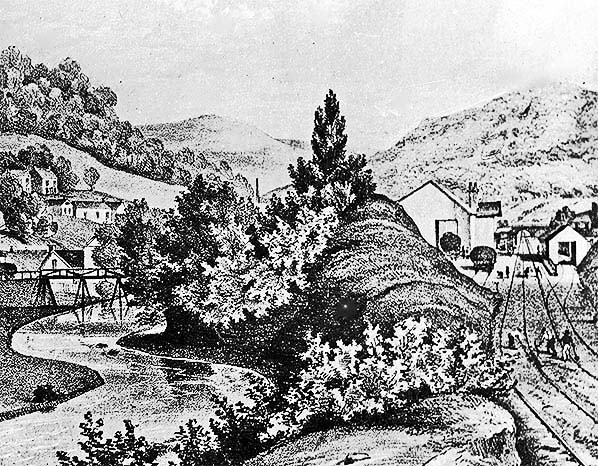

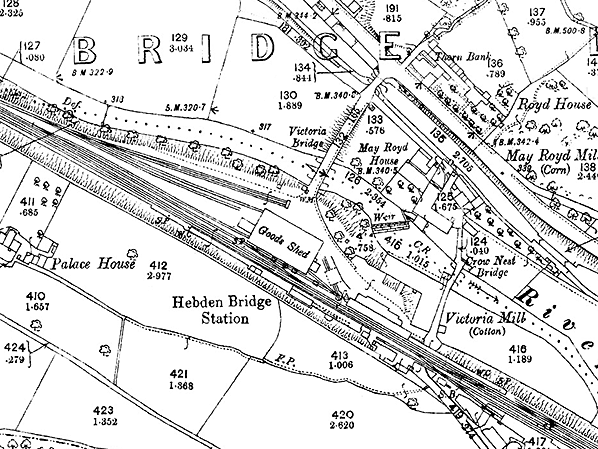
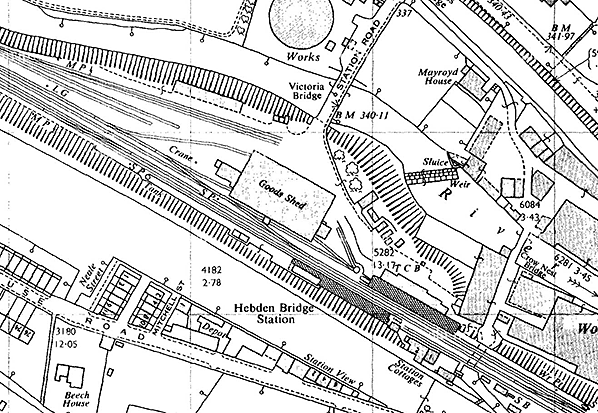
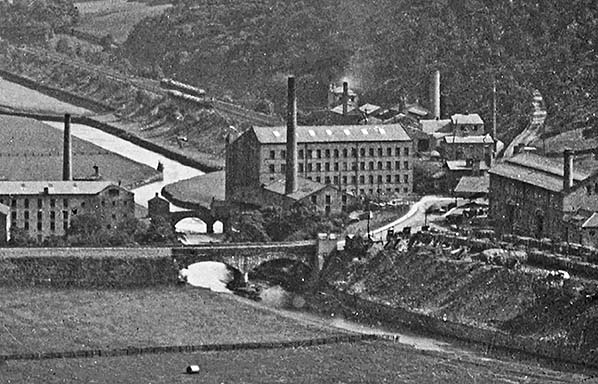
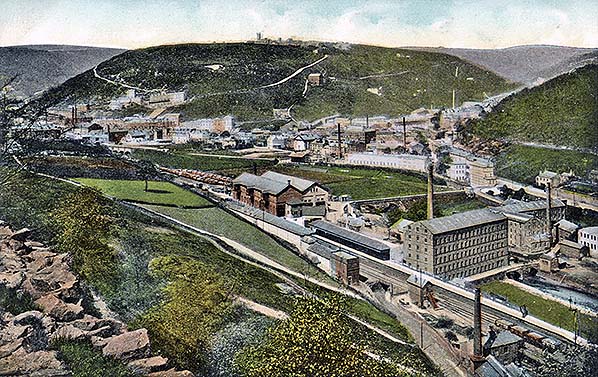
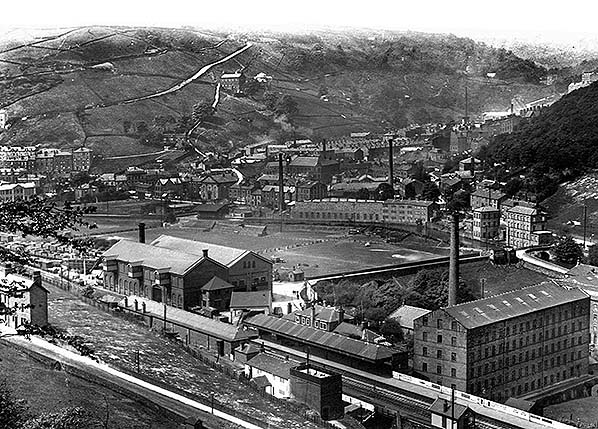
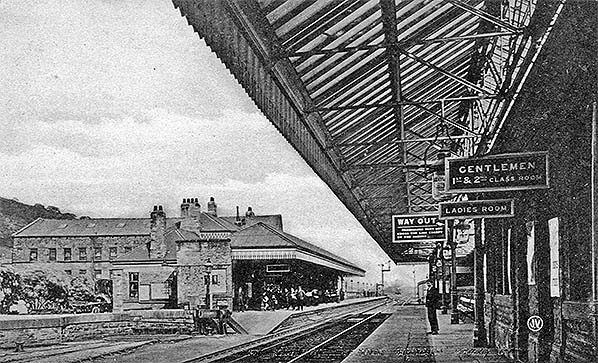
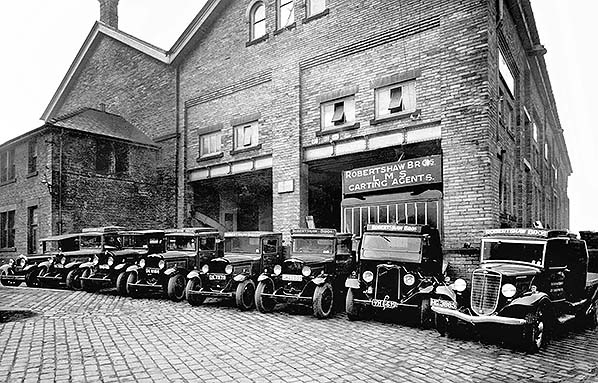
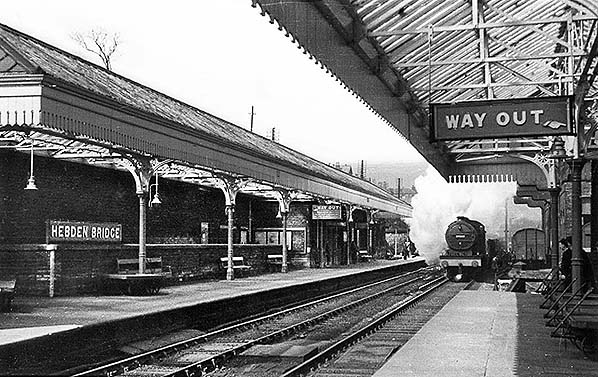
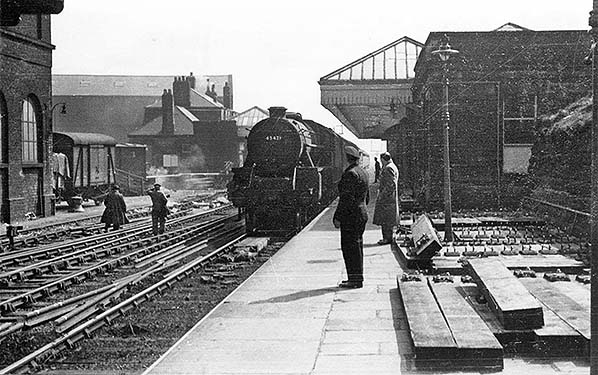
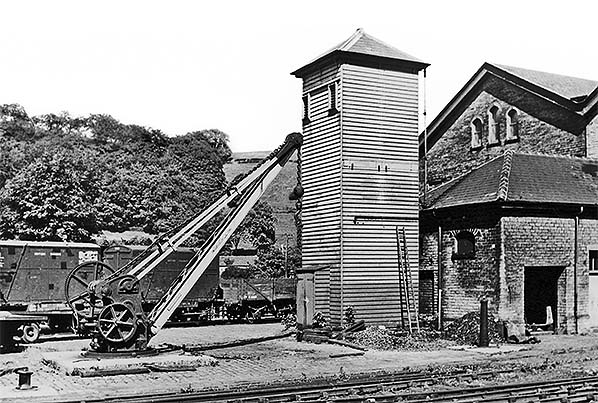
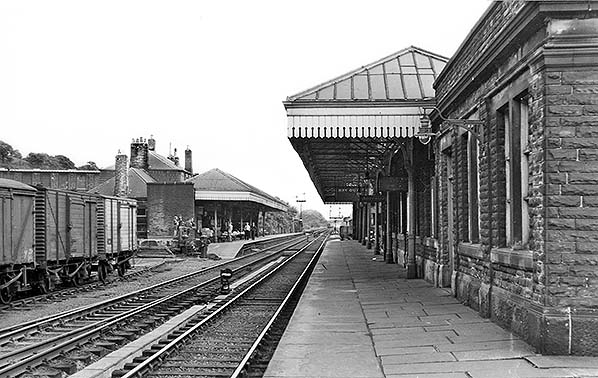 Hebden Bridge station looking south-east from the up platform in the early 1960s. The goods facilities are still in use, with the siding to the left occupied by wagons. In the background Victoria Mill, beyond the main building, has been reduced in height in comparison to its size on earlier photos. The passenger station looks very much as it does today, although the masonry seen here is soot-blackened and the gas lamps are genuine; in 2016 the sandstone structure has been cleaned and restored to its pale cream colour (the work being done in the 1970s) and the ‘gas lamps’ are electrically lit.
Hebden Bridge station looking south-east from the up platform in the early 1960s. The goods facilities are still in use, with the siding to the left occupied by wagons. In the background Victoria Mill, beyond the main building, has been reduced in height in comparison to its size on earlier photos. The passenger station looks very much as it does today, although the masonry seen here is soot-blackened and the gas lamps are genuine; in 2016 the sandstone structure has been cleaned and restored to its pale cream colour (the work being done in the 1970s) and the ‘gas lamps’ are electrically lit. Notes: Hebden Bridge station is by no means an architectural gem, but it is a wonderfully preserved and refurbished example of a small town station, the likes of which could be found throughout the British railway network until the 1960s when closure, or demolition of the old buildings and their replacement with ‘bus’ shelters, almost eliminated them; as such it is a place to savour. Knaresborough and Hexham are two other stations in northern England of similar size and character, although these have not retained the pre-Grouping signage found at Hebden Bridge.
Notes: Hebden Bridge station is by no means an architectural gem, but it is a wonderfully preserved and refurbished example of a small town station, the likes of which could be found throughout the British railway network until the 1960s when closure, or demolition of the old buildings and their replacement with ‘bus’ shelters, almost eliminated them; as such it is a place to savour. Knaresborough and Hexham are two other stations in northern England of similar size and character, although these have not retained the pre-Grouping signage found at Hebden Bridge. 
 The original station at Hebden Bridge dated from the opening of the railway on 5 October 1840. Until 1 January 1841 it was the western terminus of the line from Leeds and Normanton; on this date the line was extended through Eastwood and Todmorden to the northern end of the Summit Tunnel. From 1 March 1841, when the line through the tunnel was opened to meet the existing rails from Manchester, trains used the entire route through Hebden Bridge between Manchester and Leeds. At Hebden Bridge the building was on the down (Leeds-bound) platform, of two storeys aligned at right angles to the platform and with a pitched roof which prominently overhung the gables, rather in the style of some G T Andrews buildings on the York & North Midland Railway. A goods warehouse was placed to the north-west of the platform. On the up platform there were no facilities, but a single-road engine shed backed onto it. The first timetable (when Hebden Bridge was the western terminus) showed departures to Leeds at 8.00 and 11.30am and at 3.15pm; arrivals from Leeds were at 9.36 and 11.50am and 4.50pm. At Normanton passengers could change for York, Hull, Sheffield and Derby and from there to Birmingham and London. A horse-drawn coach conveyed passengers to and from Littleborough pending the completion of Summit Tunnel.
The original station at Hebden Bridge dated from the opening of the railway on 5 October 1840. Until 1 January 1841 it was the western terminus of the line from Leeds and Normanton; on this date the line was extended through Eastwood and Todmorden to the northern end of the Summit Tunnel. From 1 March 1841, when the line through the tunnel was opened to meet the existing rails from Manchester, trains used the entire route through Hebden Bridge between Manchester and Leeds. At Hebden Bridge the building was on the down (Leeds-bound) platform, of two storeys aligned at right angles to the platform and with a pitched roof which prominently overhung the gables, rather in the style of some G T Andrews buildings on the York & North Midland Railway. A goods warehouse was placed to the north-west of the platform. On the up platform there were no facilities, but a single-road engine shed backed onto it. The first timetable (when Hebden Bridge was the western terminus) showed departures to Leeds at 8.00 and 11.30am and at 3.15pm; arrivals from Leeds were at 9.36 and 11.50am and 4.50pm. At Normanton passengers could change for York, Hull, Sheffield and Derby and from there to Birmingham and London. A horse-drawn coach conveyed passengers to and from Littleborough pending the completion of Summit Tunnel. The passenger accommodation proved to be inadequate so in 1891/92 new buildings were constructed by the Lancashire & Yorkshire Railway (LYR). Biddle (1973) describes the architecture of the new building as ‘a cheerful smaller edition’ of Nelson station (1892), some 12 miles to the west. At Hebden Bridge the sandstone main building is on the down platform (No.2) today used by trains towards Halifax, Bradford, Mirfield and Leeds. Its central two-storey section which contains the booking hall has a Mansard roof broken by three tall dormers, the central one surmounted by a gable. A bold cornice divides the upper from the lower storey. Single-storey wings, stepped back slightly from the central section, extend on either side, each under a hipped roof. The north-western wing contained the parcel office, but a café (the ‘Coffee Station’) now operates from this room. In the south-eastern wing are a waiting room and toilets. As the land drops away to the south-east, that end of the building is carried on an ‘undercroft’ storey. The upper storey was the stationmaster’s quarters (now used by a children’s nursery). On the platform elevation a handsome, hipped glazed awning with a deep valance extends the full length of the building, supported by a series of iron columns and brackets containing a wheel motif in the spandrels. The up platform (No.1) used by trains to Rochdale, Manchester, Burnley, Blackburn and Preston is backed by a screen wall and is sheltered by a lengthy awning of the same design. At the north-western end of the screen wall is a waiting room. The staggered platforms are connected by a subway, oddly reached by stairs on the down side and a ramp on the other. A hydraulic luggage lift, understood to be the oldest in place at any British station, but no longer used, connects the down platform with the subway.
The passenger accommodation proved to be inadequate so in 1891/92 new buildings were constructed by the Lancashire & Yorkshire Railway (LYR). Biddle (1973) describes the architecture of the new building as ‘a cheerful smaller edition’ of Nelson station (1892), some 12 miles to the west. At Hebden Bridge the sandstone main building is on the down platform (No.2) today used by trains towards Halifax, Bradford, Mirfield and Leeds. Its central two-storey section which contains the booking hall has a Mansard roof broken by three tall dormers, the central one surmounted by a gable. A bold cornice divides the upper from the lower storey. Single-storey wings, stepped back slightly from the central section, extend on either side, each under a hipped roof. The north-western wing contained the parcel office, but a café (the ‘Coffee Station’) now operates from this room. In the south-eastern wing are a waiting room and toilets. As the land drops away to the south-east, that end of the building is carried on an ‘undercroft’ storey. The upper storey was the stationmaster’s quarters (now used by a children’s nursery). On the platform elevation a handsome, hipped glazed awning with a deep valance extends the full length of the building, supported by a series of iron columns and brackets containing a wheel motif in the spandrels. The up platform (No.1) used by trains to Rochdale, Manchester, Burnley, Blackburn and Preston is backed by a screen wall and is sheltered by a lengthy awning of the same design. At the north-western end of the screen wall is a waiting room. The staggered platforms are connected by a subway, oddly reached by stairs on the down side and a ramp on the other. A hydraulic luggage lift, understood to be the oldest in place at any British station, but no longer used, connects the down platform with the subway. The rebuilding of the station coincided with the provision of a new signal box in 1891. Originally known as Hebden Bridge East it was equipped with a 36-lever LYR frame, later extended to 38 levers. Hebden Bridge West box, which was situated adjacent to the goods yard, closed in 1934 and was replaced with a 2-lever ground frame released from the existing box.
The rebuilding of the station coincided with the provision of a new signal box in 1891. Originally known as Hebden Bridge East it was equipped with a 36-lever LYR frame, later extended to 38 levers. Hebden Bridge West box, which was situated adjacent to the goods yard, closed in 1934 and was replaced with a 2-lever ground frame released from the existing box. Under LMS administration the station retained its Victorian atmosphere, and the company imposed its character in a limited way by installing ‘Sugg’ gas lamps, lamp nameplates and distinctive ‘Hawkseye’ nameboards with black lettering on a yellow field. Shortly before the Second World War Hebden Bridge’s train service had become generous, particularly on summer Saturdays when extra trains called travelling to or from resorts such as Blackpool, Morecambe and Llandudno. The intervals between trains in this timetable remain erratic. A couple of long-distance services run to Newcastle and to Edinburgh / Glasgow. As in the 1922 timetable, Bradford (Exchange) and Leeds (Central) are shown as Bradford and Leeds. Some down trains are divided and the two destinations are shown (e.g.) Bradford/Leeds; in this case trains are divided at Low Moor station. In the opposite direction trains would be amalgamated here.
Under LMS administration the station retained its Victorian atmosphere, and the company imposed its character in a limited way by installing ‘Sugg’ gas lamps, lamp nameplates and distinctive ‘Hawkseye’ nameboards with black lettering on a yellow field. Shortly before the Second World War Hebden Bridge’s train service had become generous, particularly on summer Saturdays when extra trains called travelling to or from resorts such as Blackpool, Morecambe and Llandudno. The intervals between trains in this timetable remain erratic. A couple of long-distance services run to Newcastle and to Edinburgh / Glasgow. As in the 1922 timetable, Bradford (Exchange) and Leeds (Central) are shown as Bradford and Leeds. Some down trains are divided and the two destinations are shown (e.g.) Bradford/Leeds; in this case trains are divided at Low Moor station. In the opposite direction trains would be amalgamated here. At nationalisation in January 1948 the LMS lines in England and Wales became the basis of the new British Railways’ London Midland Region; however, all of the Leeds and Bradford area’s lines were transferred to the North Eastern Region (NE) on 2 April 1950 and Hebden Bridge became the frontier NE station. The NE Region retained the station’s LYR and LMS signs but painted them in the region’s cheerful tangerine colour.
At nationalisation in January 1948 the LMS lines in England and Wales became the basis of the new British Railways’ London Midland Region; however, all of the Leeds and Bradford area’s lines were transferred to the North Eastern Region (NE) on 2 April 1950 and Hebden Bridge became the frontier NE station. The NE Region retained the station’s LYR and LMS signs but painted them in the region’s cheerful tangerine colour. In the service shown below for summer 1964 the off-peak departures from Hebden Bridge have become at least approximately hourly apart from an early-afternoon gap in the up service, plus seasonal extras on Saturday. A few trains still travel westwards via Copy Pit. This was the final summer when trains ran to Blackpool Central; Beeching (1963) had proposed closure of Blackpool North station, but the town council had notions of an ambitious development on the site of Central station (which did not materialise) and insisted that Central should close instead, with longer-distance trains being diverted to Blackpool North. In the summer 1962 timetable the practice of dividing trains at Low Moor into Bradford Exchange and Leeds Central portions at Low Moor ceased and trains ran through to Leeds, reversing at Bradford: no problem for DMUs. In the same timetable through workings were introduced via Bradford (reverse) and Leeds (reverse) to Harrogate. Through trains to Harrogate ran until September 1967, but from 1 May when Leeds Central closed they were diverted via Leeds City (reverse).
In the service shown below for summer 1964 the off-peak departures from Hebden Bridge have become at least approximately hourly apart from an early-afternoon gap in the up service, plus seasonal extras on Saturday. A few trains still travel westwards via Copy Pit. This was the final summer when trains ran to Blackpool Central; Beeching (1963) had proposed closure of Blackpool North station, but the town council had notions of an ambitious development on the site of Central station (which did not materialise) and insisted that Central should close instead, with longer-distance trains being diverted to Blackpool North. In the summer 1962 timetable the practice of dividing trains at Low Moor into Bradford Exchange and Leeds Central portions at Low Moor ceased and trains ran through to Leeds, reversing at Bradford: no problem for DMUs. In the same timetable through workings were introduced via Bradford (reverse) and Leeds (reverse) to Harrogate. Through trains to Harrogate ran until September 1967, but from 1 May when Leeds Central closed they were diverted via Leeds City (reverse). The future of Hebden Bridge station must have seemed insecure in the late 1960s as the NE Region showed no interest in modernising it; nor did the Eastern Region, which absorbed the NE in January 1967. A newspaper article celebrating the opening of Britain’s first park-and-ride station at New Pudsey (between Bradford and Leeds) in that year contrasted its modernity with the ‘flickering gas lamps’ at Hebden Bridge. The station’s goods yard closed in May 1966 and the large warehouse was damaged by fire in 1969 and swiftly demolished; a car park was opened on its site in 1994, but part of the goods yard has continued to be used by a coal merchant.
The future of Hebden Bridge station must have seemed insecure in the late 1960s as the NE Region showed no interest in modernising it; nor did the Eastern Region, which absorbed the NE in January 1967. A newspaper article celebrating the opening of Britain’s first park-and-ride station at New Pudsey (between Bradford and Leeds) in that year contrasted its modernity with the ‘flickering gas lamps’ at Hebden Bridge. The station’s goods yard closed in May 1966 and the large warehouse was damaged by fire in 1969 and swiftly demolished; a car park was opened on its site in 1994, but part of the goods yard has continued to be used by a coal merchant.  The growing confidence and enterprise of Hebden Bridge’s residents enabled them to confront British Rail’s inflexible aesthetic mediocrity of the late 1970s and enjoy victory. BR yielded to local pressure and repainted the station in Lancashire & Yorkshire Railway colours, with the signs all being given a coat of chocolate and white; BR even replaced the black and white nameplates with unique chocolate and white specimens, but the typeface obstinately remained BR ‘Rail Alphabet’. The work had been completed by summer 1980. Railway Magazine (January 1981) reported that the Chairman of Calder Civic Trust had presented the BR Area Manager with a commemorative plaque as a token of thanks. A further concession to the station’s historic atmosphere was the restoration of ‘heritage’ Sugg lamps (by late 1991) albeit electrically lit; this welcome touch reflected a national trend, which saw such lighting appear in many town centres and in stations as widely spread as Huddersfield, Drem and Littleport. In 1998 Hebden Bridge station, and the signal box, underwent restoration.
The growing confidence and enterprise of Hebden Bridge’s residents enabled them to confront British Rail’s inflexible aesthetic mediocrity of the late 1970s and enjoy victory. BR yielded to local pressure and repainted the station in Lancashire & Yorkshire Railway colours, with the signs all being given a coat of chocolate and white; BR even replaced the black and white nameplates with unique chocolate and white specimens, but the typeface obstinately remained BR ‘Rail Alphabet’. The work had been completed by summer 1980. Railway Magazine (January 1981) reported that the Chairman of Calder Civic Trust had presented the BR Area Manager with a commemorative plaque as a token of thanks. A further concession to the station’s historic atmosphere was the restoration of ‘heritage’ Sugg lamps (by late 1991) albeit electrically lit; this welcome touch reflected a national trend, which saw such lighting appear in many town centres and in stations as widely spread as Huddersfield, Drem and Littleport. In 1998 Hebden Bridge station, and the signal box, underwent restoration. The station is undoubtedly one of the showpieces of the National Rail network and a reminder of the charm that so many stations once possessed. Until the early 1960s many stations benefitted from the loving attention of their staff who tended the gardens and bedecked them in hanging baskets - and proudly displayed certificates in recognition of their efforts. Each summer Hebden Bridge station recaptures these bygone days with splendid floral displays, as seen in some of the accompanying photographs; not surprisingly it has received a ‘Britain in Bloom’ award. This relatively minor station is unusual today in having a café – The Coffee Station – which occupies the former Parcel Office. Its fittings, although new, look as if they have been there since the station was built. The waiting rooms are beautifully presented with displays of historic local railway photographs; the down platform waiting room also boats a piano and a small library. Even the approach to the station has been made attractive as the tarmac road up to the entrance has given way to a paved area with seating and floral displays.
The station is undoubtedly one of the showpieces of the National Rail network and a reminder of the charm that so many stations once possessed. Until the early 1960s many stations benefitted from the loving attention of their staff who tended the gardens and bedecked them in hanging baskets - and proudly displayed certificates in recognition of their efforts. Each summer Hebden Bridge station recaptures these bygone days with splendid floral displays, as seen in some of the accompanying photographs; not surprisingly it has received a ‘Britain in Bloom’ award. This relatively minor station is unusual today in having a café – The Coffee Station – which occupies the former Parcel Office. Its fittings, although new, look as if they have been there since the station was built. The waiting rooms are beautifully presented with displays of historic local railway photographs; the down platform waiting room also boats a piano and a small library. Even the approach to the station has been made attractive as the tarmac road up to the entrance has given way to a paved area with seating and floral displays.
 Home Page
Home Page